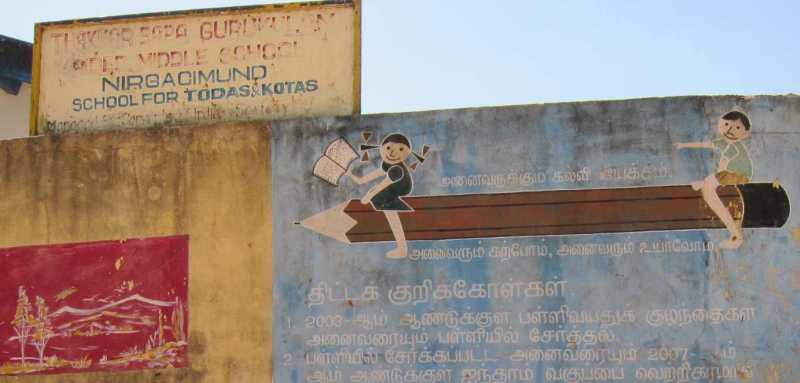
Scheduled Tribes of Tamilnadu
ADI DRAVIDAR AND TRIBAL WELFARE DEPARTMENT POLICY NOTE 2018 – 2019 INTRODUCTION:
As per the census of 2011, the population of Tamil Nadu is 7.21 crore [72,1 million] of which Scheduled Castes (known as Adi Dravidar in Tamil Nadu) are 1.44 crore (20.01%) and Scheduled Tribes are 7.95 lakh [795.000] (1.10%). The mandate of this Department is to address the causes for their handicaps, backwardness and uplift them in socio, economic and education on par with the rest of the society.This department is concerned with overall policy formulation, planning and implementation of these welfare programmes reflecting the policies of the State Government for their accelerated growth in their socio-economic status, educational development and ensuring their sustained growth and social dignity. In order to ensure the all round development of the Adi Dravidar and Scheduled Tribes, this Government is implementing various welfare schemes for which a sum of Rs.3549.65 Crore has been provided in the Budget Estimate for the year 2018-2019.
With the principal ideology that Education only can bring changes in the society, this Department lays great emphasis on the educational sector as a means to uplift and empower the Adi Dravidar and Scheduled Tribes. […]
As per the Scheduled Castes and Scheduled Tribes Orders (Amendment) Act 1976, there are 36 Tribal community in Tamil Nadu. They are (1) Adiyan (2) Aranadan (3) Eravallan (4) Irular (5) Kadar (6) Kammara (7) Kanikaran or Kanikkar (8) Kaniyan or Kanyan (9) Kattunayakan (10)Kochu Velan (11) Konda Kapus (12) Kondareddis (13) Koraga (14) Kota, (15) Kudiya or Melakudi (16) Kurichchan (17) Kurumbas (18) Kurumans (19) Maha Malasar (20) Malai Arayan (21) Malai Pandaram (22) Malai Vedan (23) Malaikkuravan (24) Malasar (25) Malayali (26) Malayakandi (27) Mannan (28) Mudugar or Muduvan (29) Muthuvan (30) Pallayan (31) Palliyan (32) Palliyar (33) Paniyan (34) Sholaga (35) Toda** (36) Uraly.
(*Kanniyakumari and Shenkottah Taluk of Tirunelveli District)
(** Except Kanniyakumari and Shenkottah Taluk of Tirunelveli District)
55
Out of the 36 Tribal communities in Tamilnadu, 6 Tribal Communities i.e. Toda, Kota, Kurumbas, Irular, Paniyan and Kattunayakan are classified as Particularly Vulnerable Tribal Groups (PVTGs).
1. Education (i) Schools
In order to improve the literacy of Tribal people through education, this Department has established and is running Residential schools near their habitations.
Details of schools functioning under Tribal Welfare Department and students strength
| Sl. No. | Classification of Schools | No. of Schools | No. of Students |
| 1 | Government Tribal Residential School (GTR) | 308 | 26,388 |
| 2 | Eklavya Model Residential School (EMRS) | 7 | 1,553 |
| Total | 315 | 27,941 |
Source: POLICY NOTE 2018 – 2019 by ADI DRAVIDAR AND TRIBAL WELFARE DEPARTMENT Scheduled Tribes of Tamilnadu (pp. 1-2, Introduction and pp. 55-56)
URL: http://cms.tn.gov.in/sites/default/files/documents/adtw_e_pn_2018-19.pdf
Date visited: 12 July 2019
[Bold typeface added above for emphasis]
Objective of EMRS (“Eklavya Model Residential Schools”)
[Peruse the government guidelines here or in the 2010 backup included below]
i. Comprehensive physical, mental and socially relevant development of all students enrolled in each and every EMRS. Students will be empowered to be change agent, beginning in their school, in their homes, in their village and finally in a large context.
ii. Focus differentially on the educational support to be made available to those in Standards XI to X, so that their distinctive needs can be met.
iii. Support the annual running expenses in a manner that offers reasonable remuneration to the staff and upkeep of the facilities.
iv. Support the construction of infrastructure that provides education, physical, environmental and cultural needs of student life. […]
Source: REVISED GUIDELINES FOR SETTING UP EKLAVYA MODEL RESIDENTIAL SCHOOL (EMRS)June 2010
URL: https://tribal.gov.in/DivisionsFiles/sg/EMRSguidlines.pdf
Date visited: 30 Jul7 2021
Ekalavya (Eklavya, Eklabya), EMR & Factory schools >>
‘Kaathadi’ is a YouTube channel collectively built by students and teachers from the tribal communities in the Nilgiris
The full story with more pictures | New Indian Express >>
To peruse related documents published by government agencies and NGOs, click here >>
Reports in the Indian press | List of periodicals included in this search >>
Search tips
Combine the name of any particular state, language or region with that of any tribal (Adivasi) community.
Add keywords of special interest (music, poetry, dance just as health, sacred grove and biodiversity); learn about the rights of Scheduled Tribes such as the “Forest Rights Act” (FRA); and the United Nations “Declaration on the Rights of Indigenous Peoples”, “Universal Declaration of Human Rights”, “women’s rights”, or “children’s right to education”.
Ask a question that includes “tribal” or “Adivasi”, for instance: “Adivasi way of life better?” (or “tribal way of life worse?”)
Specify any particular issue or news item (biodiversity, bonded labour and human trafficking, climate change, ecology, economic development, ethnobotany, ethnomedicine, global warming, hunter-gatherers in a particular region or state, prevention of rural poverty, water access).
For official figures include “scheduled tribe ST” along with a union state or region: e.g. “Chhattisgarh ST community”, “Himalayan tribe”, “Scheduled tribe Tamil Nadu census”, “ST Kerala census”, “Particularly Vulnerable Tribal Group Jharkhand”, “PVTG Rajasthan”, “Adivasi ST Kerala”, “Adibasi ST West Bengal” etc.
In case the Google Custom Search window is not displayed here try the following: (1) toggle between “Reader” and regular viewing; (2) in your browser’s Security settings select “Enable JavaScript” | More tips >>
Note: hyperlinks and quotes are meant for fact-checking and information purposes only | Disclaimer >>
Research the above issues with the help of Shodhganga: A reservoir of theses from universities all over India, made available under Open Access >>